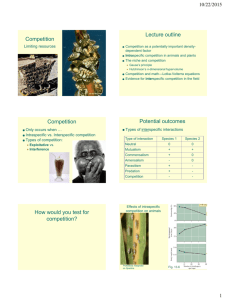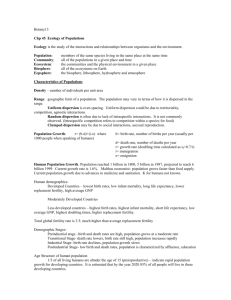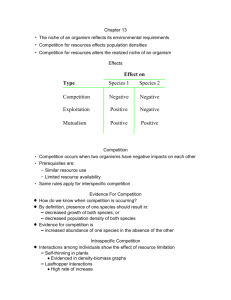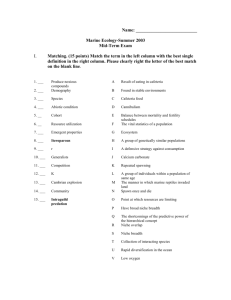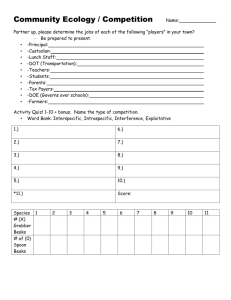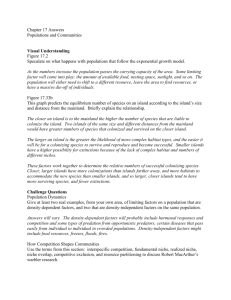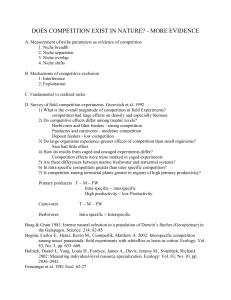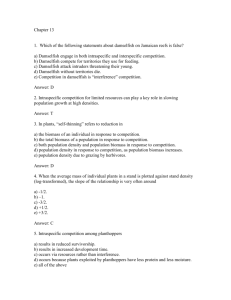15 Competition 2008
advertisement
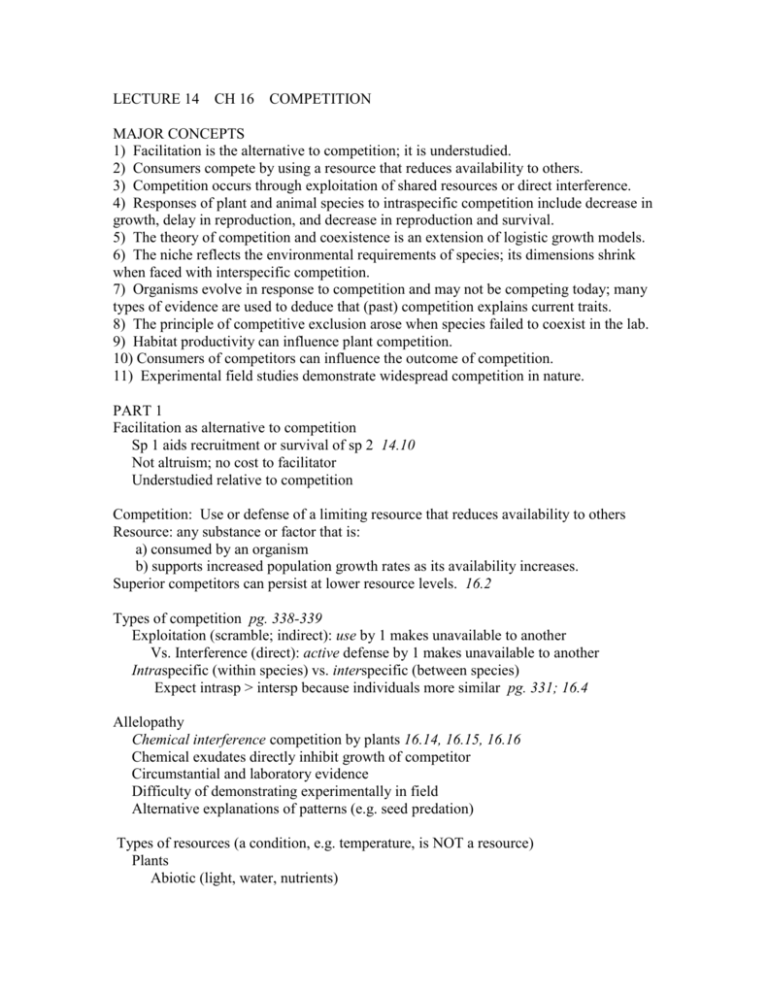
LECTURE 14 CH 16 COMPETITION MAJOR CONCEPTS 1) Facilitation is the alternative to competition; it is understudied. 2) Consumers compete by using a resource that reduces availability to others. 3) Competition occurs through exploitation of shared resources or direct interference. 4) Responses of plant and animal species to intraspecific competition include decrease in growth, delay in reproduction, and decrease in reproduction and survival. 5) The theory of competition and coexistence is an extension of logistic growth models. 6) The niche reflects the environmental requirements of species; its dimensions shrink when faced with interspecific competition. 7) Organisms evolve in response to competition and may not be competing today; many types of evidence are used to deduce that (past) competition explains current traits. 8) The principle of competitive exclusion arose when species failed to coexist in the lab. 9) Habitat productivity can influence plant competition. 10) Consumers of competitors can influence the outcome of competition. 11) Experimental field studies demonstrate widespread competition in nature. PART 1 Facilitation as alternative to competition Sp 1 aids recruitment or survival of sp 2 14.10 Not altruism; no cost to facilitator Understudied relative to competition Competition: Use or defense of a limiting resource that reduces availability to others Resource: any substance or factor that is: a) consumed by an organism b) supports increased population growth rates as its availability increases. Superior competitors can persist at lower resource levels. 16.2 Types of competition pg. 338-339 Exploitation (scramble; indirect): use by 1 makes unavailable to another Vs. Interference (direct): active defense by 1 makes unavailable to another Intraspecific (within species) vs. interspecific (between species) Expect intrasp > intersp because individuals more similar pg. 331; 16.4 Allelopathy Chemical interference competition by plants 16.14, 16.15, 16.16 Chemical exudates directly inhibit growth of competitor Circumstantial and laboratory evidence Difficulty of demonstrating experimentally in field Alternative explanations of patterns (e.g. seed predation) Types of resources (a condition, e.g. temperature, is NOT a resource) Plants Abiotic (light, water, nutrients) Biotic (symbionts, pollinators, seed dispersers) Animals Abiotic (space, territory, hiding places) 16.3 Biotic (food) Renewable (constantly regenerated) pg. 332 Non-renewable (occur in fixed amounts and can be fully re-used) Liebig’s Law of Minimum pg. 332 Population limited by the most scarce single resource Assumes no interaction between resources in determining response Can be violated because of interaction and synergism between resources 16.5, 16.6 Law of constant yield: if exceed K in planting density, no increase in population size above K Consequences of competition for population growth: Intraspecific competition in plants density-dependence of population growth Decreases growth and size hierarchies develop (competition as selective force) Decreases reproduction (births) Increases mortality (deaths) (‘self-thinning’ of population) Intraspecific competition in animals density-dependence of population growth Decreases growth Increases age of sexual maturity (delays births) Decreases births + increases mortality lowers r Logistic equation extended to include theory of competition and coexistence Based on intraspecific competition decreases per capita pop. growth rate via density-dependent birth and death rates; causes r to decrease Population size continues to increase until N = K, but rate of pop growth slows as N approaches K (as (K-N)/K approaches 0) at K, r = 0 16,8 Additions to logistic growth equations Modified to include interspecific competition; 16.9 add effects of sp 1 on 2; sp 2 on 1 Competition coefficients: conversion factor to convert sp 2 individuals into equivalent # of sp 1 Presence of sp 2 decreases size of K available to sp 1 = effect of sp2 on sp 1 N1 = N2 = saturating effect = effect of sp1 on sp2 N2 = N1 = saturating effect + = proportionality constants of effect of 1 sp on 2nd sp dN1/dt = r1N1 (K1 - N1 - N2) / K1 dN2dt = r2N2 (K2 – N2 - N1) / K2 PART 2 Niche pg. 423-4 Ranges of conditions and resource qualities within which species persists Niche axis Niche breadth Multiple niche axes hypervolume In practice, study 1 or 2 axes Fundamental niche (without competitors) Vs. Realized niche (with competitors) pg.200 Intraspecific competition selects for broader niche Interspecific competition may select for narrower niche (leads to specialization) Interspecific competition ‘Ghost of competition past’: today’s organisms no longer in competition because of past selection to avoid competition Often lose evidence of competitive exclusion because poor competitor is gone Types of evidence used to deduce that (past) competition explains current traits Niche separation (resource partitioning); reduced niche overlap Habitat shift Character displacement pg. 359 17.16, 17.17 Competitive exclusion: two species can’t coexist on same limiting resource 16.7 Classic experiments of interspecific competition Winner of competition can depend on environmental conditions Two species can coexist if limited by different resources 16.10 Competitive release when one competitor is gone Predation can influence outcome of competition Predators can maintain prey species diversity by reducing superior competitors 16.17, 16.18 Apparent competition: Herbivores or predators can determine the competitive balance 16.19, 16.20 Field studies: how demonstrate competition? Introduce (add) species it excludes related species Removal of species competitive release (increase in remaining competitors) Compare intra-vs. interspecific competition in field 16.1 Both can occur simultaneously Evidence of asymmetric competition 16.11 Sp 1 controls Sp 2 in Sp 2’s habitat, but not vice versa Occurs when different factors limit the populations of competitors Possibility of tradeoffs: superior competitive ability in favorable habitat may be linked to poor tolerance of stressful conditions; and vice versa Summary 1-16!
